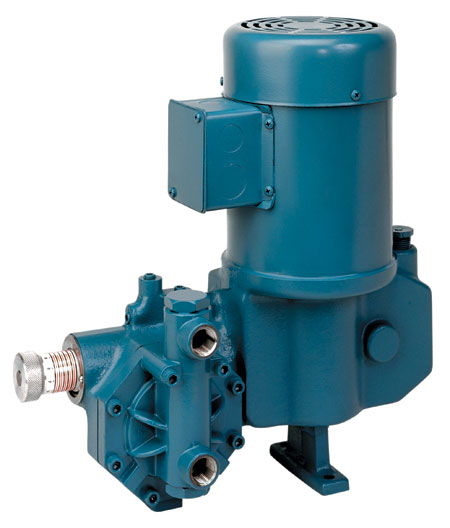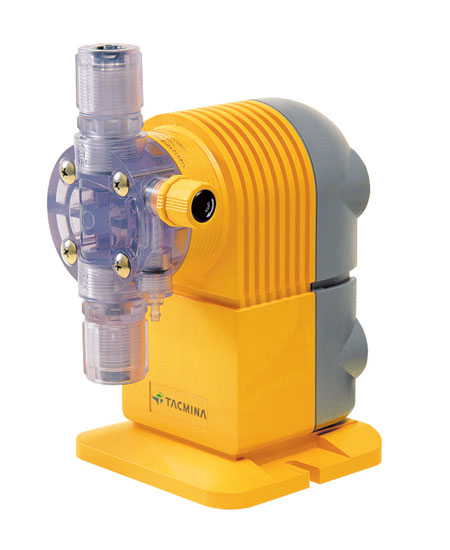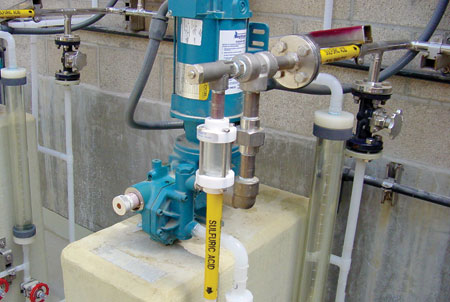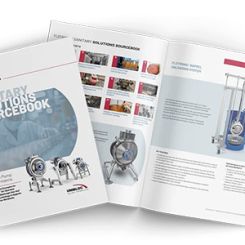The Challenge
At their simplest, metering pumps are used to inject liquids at precisely controlled, adjustable flow rates, which is a process called metering. As defined by the Hydraulic Institute's Metering Pump Section, controlled-volume metering pumps are reciprocating, positive displacement pumps typically used for the injection of chemical additives, proportional blending of multiple components or metered transfer of a single liquid.
Metering pumps pump chemical solutions and expensive additives for products manufactured in a wide variety of industries, including industrial, medical, chemical, food and dairy, pharmaceutical and biotech, environmental, fuel cell and laboratory. Metering pumps are designed to pump into low or high discharge pressures at controlled flow rates that are constant when averaged over time. Metering pumps consist of a solenoid drive or a gearbox with motor, control mechanism and pump head with valves to control the flow direction through which the liquid pumped enters the inlet connection and exits the discharge connection.
Since liquids are only slightly compressible, they can be discharged at high pressure by metering pumps. Gases, on the other hand, are much more compressible, making them incompatible with metering pump use. Therefore, problems can occur in a metering pump application when gas bubbles enter the pump head. When this happens, the pump can suffer from vapor lock, in which the pump will stop pumping the liquid that contains gas bubbles while repeatedly compressing and decompressing the bubbles.
Another challenge in the use of metering pumps can occur when the pump's outlet pressure is lower than the inlet pressure. When this situation arises, both check valves will open simultaneously and the liquid will flow through the pump head uncontrollably from inlet to outlet. A properly rated pressure-differential check valve placed downstream of the pump will arrest this undesirable flow condition.
Despite these concerns, metering pumps remain versatile, relied-upon technologies for the safe, accurate and efficient injection of a unique array of chemicals up to 20,000 cps and slurries containing up to 10 percent solids. This article will help the user define the variables to evaluate when choosing and installing the proper metering pump or complete chemical-feed system. Choosing the proper system will not only help inject liquids or slurries regardless of viscosity, but also ensure that it is done in an efficient, environmentally friendly and energy-wise manner.

The Solution
Size does matter when determining the proper metering pump for an application-specifically, the size in terms of capacity of both the pump's flow rate and discharge pressure. Simply put, metering pumps should not be oversized. In fact, a metering pump should be sized so that its maximum expected flow rate is 85 to 90 percent of the pump's capacity, which leaves additional capacity, if needed. At the other end of the spectrum, a metering pump's minimum capacity should never be less than 10 percent of the capacity; anything less will affect the pump's accuracy.
Planning a Metering Pump Installation A metering pump installation must be planned from the day tank or liquid source up to the injection point. Remember that metering pumps will push against great pressures but they will not pull for great distances. Since it is easier to prime and more forgiving, a flooded suction is always preferred, and must be used for fluids where vapor pressure might be less than the suction lift. Be careful to limit the suction to 4 ft in a suction-lift application, and a foot valve must be used in a top-mount application. Limit the length of a flooded suction to 6 or 7 ft and use an adequately sized line with minimized bends, elbows or other restrictions. When considering the piping, the safest rule-of-thumb for selecting suction pipe size is to use one size larger than the pump suction connection. For discharge piping, specify piping suitable for the discharge pressure. Other accessories to consider when planning a metering pump installation include: *Suction strainer Remember that when replacing equipment or changing chemical programs, it is best to ask questions. Will the new program operate at the same feed rates as the previous one? Is the equipment properly sized for the new products? How well has the equipment been operating? Any problems with reliability, accuracy or unusually high maintenance requirements? There is no better start to a new chemical-feed program than to ensure that the chemical is delivered accurately with trouble-free equipment. |
Determining the proper flow rate and discharge pressure cannot be done until the types of substances to be pumped are identified per the application, including the viscosity of the liquid or if it is a slurry. Standard metering pumps handle clear liquids with viscosities generally ranging from water-which has a viscosity around 1 cps-to 1,500 cps. Special liquid ends for applications outside this viscosity range are available for viscosities up to 5,000 cps. When considering true slurries or liquids with even higher viscosities, special tubular diaphragm heads are compatible with viscosities to 20,000 cps and slurries that contain 10 percent solids.
Materials of construction are another consideration. When selecting a metering pump, consider any corrosion, erosion or solvent action that may occur when handling specific substances. For example, solvents may dissolve plastic-headed pumps, acids and caustics are only compatible with stainless steel or certain steel alloys, and abrasive slurries can erode some materials. The best metering pump lines are available in a range of construction materials, allowing the end user to choose the best option for his specific applications.
When considering the type of head the pump should feature, remember that double-diaphragm heads with leak detection and alarm capabilities are available for applications where any diaphragm failure must be sensed immediately.
Selecting a driver is also an area of concern. A driver should be chosen by matching it to the available utilities, which usually include electric, air, gas or other means of driving the pump. When the pump's parameters are determined, consider the environment in which the pump will operate. Hazardous area requirements must be identified when selecting the driver. When evaluating a hazardous environment, remember to consider dust, which can ignite, just like fumes or vapors.

Will the pump be used indoors or outdoors? If it is located outdoors, it should be sheltered from direct sunlight. For temperature requirements, most pumps will operate in freezing conditions, provided that the pumped fluid will not freeze and that the correct lubricants are selected. In this case, freeze protection and heat-tracing may be required, while operation in corrosive environments may require special pump coatings.
Determining the pump's control method is next on the list of determining factors. The choices usually include manual continuous operation, on/off operation or automatic proportional control in response to a process signal.
In general, metering pump flow rates can be manually adjusted with a micrometer dial. This manual control allows the pump to be operated between 10 and 100 percent of capacity by changing the stroke length. By comparison, a manual variable speed drive changes the stroke speed. A combination of the two may allow additional adjustability or turndown over the range of the drive, depending on the pump's stroking speed. For example, a pump operating at 75 strokes per minute (which could be decreased to 15 spm) would allow a 5:1 turndown on speed when using the variable speed drive and a 10:1 turndown on stroke length when using the micrometer dial.
Metering pump flow rates can also be controlled automatically (in response to a process signal) by electric positioners that change the pump's stroke length, or by variable speed drives that alter the stroking speed. Using a positioner gives the operator a full 10:1 turndown, which is the full adjustable range. Using a variable speed drive will supply only as much turndown as the ratio of the pump stroking speed divided by the pump's minimum operating speed.
Remember that it is not practical to use a variable speed drive on motor-driven pumps that normally operate at less than 100 spm to 150 spm. Slowing the motor causes each stroke to take longer from start to finish and, as a practical matter, motor-driven pumps should not be operated at less than 15 spm. Electronic diaphragm pumps, which are pulsed by a solenoid, can operate at less than a single stroke per minute because the characteristic and timing of each stroke, from start to finish, is the same at all stroking speeds. The moving parts in modern diaphragm pumps offer long, reliable service at all stroking speeds. The highest stroking speeds should be avoided with viscous or abrasive chemicals.

When automatic or electric stroke positioners control a metering pump, the number of doses remains constant and the dose size is reduced, thus keeping the doses uniformly distributed in a constantly flowing line. Use of a variable speed drive changes the stroke speed, while the size of the dose injected on each stroke remains the same, but makes the doses less frequent. This, however, can produce an undesirable process result in a constantly flowing line as the discreet slugs of chemical are more widely separated than if a constant dose interval were maintained.
Finally, consider the application and quality level. Is the unit used for intermittent operation in an HVAC or light-duty application where economy is an important consideration? Is the unit for an industrial plant/waste-treatment facility/refinery/power plant where ruggedness and additional features are required? Is initial cost or life cycle cost more important?
Pumps & Systems, February 2010

